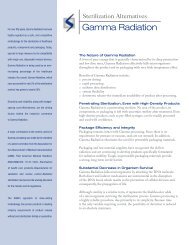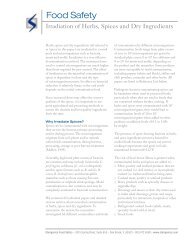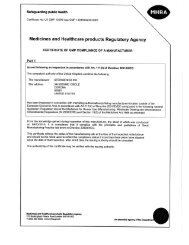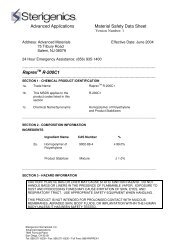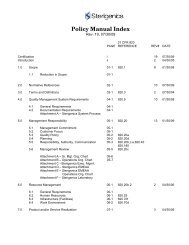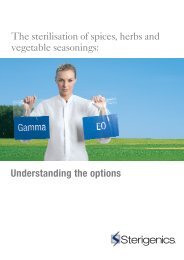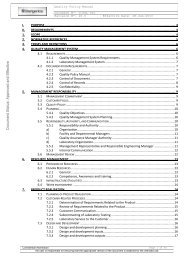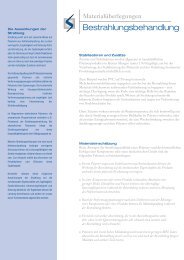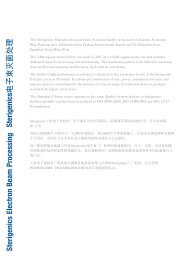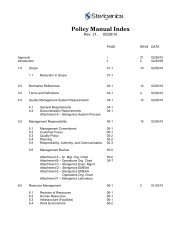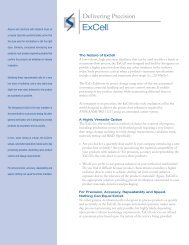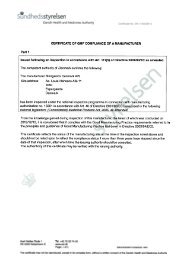Irradiation of Animal Feeds - Sterigenics
Irradiation of Animal Feeds - Sterigenics
Irradiation of Animal Feeds - Sterigenics
You also want an ePaper? Increase the reach of your titles
YUMPU automatically turns print PDFs into web optimized ePapers that Google loves.
Food Safety<br />
<strong>Irradiation</strong> <strong>of</strong> <strong>Animal</strong> <strong>Feeds</strong><br />
<strong>Irradiation</strong> is an effective microbial disinfection<br />
process for animal feeds. It is currently used<br />
in the United States for feeds for research and<br />
lab animals, and under FDA special permission<br />
letters, for dog chews to control microorganisms<br />
such as Salmonella. The irradiation <strong>of</strong> poultry<br />
feed for control <strong>of</strong> Salmonella is also approved by<br />
FDA (21 CFR § 579.40).<br />
Microbiological contamination <strong>of</strong> feed and<br />
feed ingredients is an animal health, human<br />
health and a food trade issue. <strong>Feeds</strong> are<br />
an important vector <strong>of</strong> microbial contaminants<br />
that can impair both animal health and various<br />
performance parameters. When the feed is<br />
destined for domestic pets, the presence<br />
<strong>of</strong> bacteria could affect the health <strong>of</strong> the pet’s<br />
human family. There have been several cases<br />
<strong>of</strong> children contracting Salmonellosis from<br />
handling dog chew treats. Additionally, the<br />
presence <strong>of</strong> microbiological contaminants can<br />
prevent the trade in feeds.<br />
Currently, 21 CFR § 579.22 provides for<br />
the irradiation <strong>of</strong> lab animal chow to 50 kGy,<br />
and Part 579.40 provides for poultry feed to<br />
25 kGy. There is no prescribed minimum dose<br />
for lab animal chow, but a minimum dose <strong>of</strong><br />
2.0 kGy has been prescribed for poultry feed<br />
in the regulation.<br />
<strong>Sterigenics</strong> Food Safety has prepared a petition<br />
to the US FDA–Center for Veterinary Medicine<br />
to approve the irradiation <strong>of</strong> animal feed to a<br />
maximum dose <strong>of</strong> 50 kGy.<br />
Irradiated <strong>Animal</strong> Feed Products<br />
In the United States, <strong>Sterigenics</strong> has been<br />
asked to assist feed companies and their<br />
customers to control microbial contamination<br />
<strong>of</strong> animal feeds. For example, in the past five<br />
years <strong>Sterigenics</strong> has been asked to irradiate:<br />
<br />
<br />
<br />
<br />
<br />
<br />
<br />
<br />
animal protein feed components<br />
(from blood, eggs, organ meats and<br />
rendered products)<br />
plant protein feed components<br />
such as Brewer’s Yeast<br />
dog food (dry and semi-moist), including<br />
dog chews (such as pigs ears, bullwinkles,<br />
rawhide and similar items)<br />
aquaculture feeds and pet fish food<br />
various foods for zoo and aquarium<br />
animals and creatures<br />
high value starter diets for young animals<br />
(calf, swine)<br />
feeds for lab animals<br />
birdseed for wild and pet birds<br />
In the case <strong>of</strong> feeds destined for research<br />
animals, the industry has been able to work<br />
with manufacturers to produce sufficiently<br />
decontaminated, or even sterile feeds.<br />
In other countries, members <strong>of</strong> the contract<br />
irradiation industry have been asked to irradiate:<br />
<br />
<br />
<br />
<br />
baled forage crops (such as Timothy hay)<br />
for race horses (currently commercially<br />
irradiated for trade between Australia<br />
and New Zealand)<br />
second quality grains for animal feeds<br />
birdseed (sometimes commercially<br />
irradiated in Canada as condition <strong>of</strong> entry)<br />
components <strong>of</strong> animal medicines (currently<br />
commercially irradiated in Thailand).<br />
In addition, we believe there are other animal<br />
feeds that could benefit from irradiation<br />
treatment that have not yet been identified.<br />
How Does <strong>Irradiation</strong> Work<br />
<strong>Irradiation</strong> is a physical process using approved<br />
sources <strong>of</strong> radiation (generating gamma energy,<br />
accelerated electrons or X-rays) to disinfect<br />
<strong>Sterigenics</strong> Food Safety 2015 Spring Road, Suite 650 Oak Brook, IL 60523 800.472.4508 www.sterigenics.com
<strong>Irradiation</strong> <strong>of</strong> <strong>Animal</strong> <strong>Feeds</strong><br />
feeds. In this process, sufficient energy is<br />
absorbed by the feed to kill molds, bacteria,<br />
yeasts, insect pests and weed seeds.<br />
<strong>Irradiation</strong> is intended to disinfect feeds<br />
<strong>of</strong> microbial contamination, but since insect<br />
pests are generally more sensitive to radiation<br />
than bacteria (depending on life stage and<br />
other factors), they would usually be killed<br />
at any dose commercially used to control<br />
microbial contamination.<br />
Microbiological Effects <strong>of</strong> <strong>Irradiation</strong><br />
on Feed and Feed Components<br />
As a result <strong>of</strong> decades <strong>of</strong> research on the effects<br />
<strong>of</strong> irradiation, <strong>Sterigenics</strong> has a very complete<br />
understanding <strong>of</strong> the effect <strong>of</strong> irradiation on<br />
microbial contaminants. Most important is the<br />
general agreement in the microbiology research<br />
<strong>of</strong> the effectiveness <strong>of</strong> irradiation as a means to<br />
control microbial contamination in a wide<br />
variety <strong>of</strong> products.<br />
If we look at the detail <strong>of</strong> the research results<br />
on the effect <strong>of</strong> irradiating dry feeds, however,<br />
we do not, see an overwhelmingly consistent<br />
picture. <strong>Feeds</strong> and their ingredients vary<br />
considerably in formulation, moisture content,<br />
physical properties and bioburden.<br />
Reported D 10 values for many bacterial<br />
contaminants vary from 0.4 kGy to 2.2 kGy<br />
depending on the organism(s), type <strong>of</strong> feed and<br />
test conditions such as temperature. Where<br />
log reductions were reported, a dose range <strong>of</strong><br />
3.75-7.5 kGy was suggested to result in a 5-8<br />
log reduction in a number <strong>of</strong> bacteria<br />
(including Salmonella), and fungi. One study<br />
noted significantly lower doses were required<br />
for pelletized feeds versus non-pelletized feeds.<br />
Where the researchers noted effective<br />
sanitization doses, 5-8 kGy was considered to<br />
control coliforms; 8-15 kGy was advised to<br />
control all enterobacteria; 6.5 kGy eliminated<br />
Staphlococcus; and 2-4 kGy controlled Aspergillis.<br />
For sterility <strong>of</strong> lab animal chow, 25 kGy was<br />
recommended; that dose was also recommended<br />
in other experiments to decontaminate feeds<br />
that were probably quite contaminated.<br />
Our experience with spices, herbs, botanicals<br />
and other dry ingredients (which have a similar<br />
bioburden to many feeds, and also being<br />
relatively dry, have a similar dose response),<br />
tells us that, assuming initial bioburden levels<br />
are not unusually high, a minimum dose <strong>of</strong><br />
about 7 kGy is usually sufficient to achieve<br />
a level <strong>of</strong> decontamination that is acceptable to<br />
spice processors and their customers. However,<br />
we note that some spices, such as black pepper,<br />
known to have higher levels <strong>of</strong> contamination,<br />
<strong>of</strong>ten require a minimum dose <strong>of</strong> up to 20 kGy.<br />
Effects <strong>of</strong> <strong>Irradiation</strong> on Nutrient<br />
Value <strong>of</strong> <strong>Animal</strong> Feed<br />
The effect <strong>of</strong> irradiation on the nutrient value<br />
<strong>of</strong> the feed should be assessed as part <strong>of</strong> the dose<br />
determination before commercial processing<br />
begins. It is the manufacturers’ responsibility<br />
to ensure the nutrient value <strong>of</strong> the feed is not<br />
significantly compromised by the irradiation<br />
processing. Manufacturers <strong>of</strong> animal feeds<br />
should take note <strong>of</strong> radiation effects on key<br />
nutrients for the species being fed and<br />
supplement as necessary.<br />
Generally, the need to control microbiological<br />
contamination outranks the nutritional effects<br />
issue in decisions (since the nutrient content<br />
<strong>of</strong> animal feeds can be easily manipulated), but<br />
there are a few important issues that temper<br />
dose selection considerations.<br />
First, if the feed is destined for young animals<br />
or known-to-be-sensitive species (for example,<br />
starter feeds, aquaculture feeds for young fish<br />
or single diets for valuable zoo animals), where<br />
significant nutritional losses could result in<br />
problems with the fed species, we strongly<br />
advise the customer to test the nutritional value,<br />
focusing on nutrients that are both radiation<br />
<strong>Sterigenics</strong> Food Safety 2015 Spring Road, Suite 650 Oak Brook, IL 60523 800.472.4508 www.sterigenics.com
<strong>Irradiation</strong> <strong>of</strong> <strong>Animal</strong> <strong>Feeds</strong><br />
sensitive and key nutrients for that species.<br />
We can work with the customer to advise them<br />
about the nutrients that are known to be<br />
radiation sensitive, but we rely on the customer<br />
to know the key nutrients for the fed species.<br />
Not all feed products are significant sources<br />
<strong>of</strong> nutrients (rawhide treats as an example),<br />
so nutrient assessment is not always a necessity.<br />
We also note that while organoleptic concerns<br />
are very important aspects in dose selection<br />
for human foods, this seems to be less <strong>of</strong><br />
a consideration for the irradiation <strong>of</strong> animal<br />
feeds. We would expect the manufacturer<br />
to ensure irradiation does not affect acceptance<br />
by the fed animal.<br />
Protein and Amino Acids<br />
Crude protein levels and total nitrogen contents<br />
have not been found to be affected by irradiation<br />
treatment in the range <strong>of</strong> animal feeds tested<br />
at dose levels even as high as 150 kGy.<br />
A number <strong>of</strong> authors studying a variety <strong>of</strong> feeds,<br />
including fishmeals, meat rendering products<br />
and cereal-based diets, reported that irradiation<br />
with doses as high as 100 kGy did not affect<br />
biological value. Small losses in protein value<br />
were found in some grain products but not<br />
fishmeal or spray-dried blood protein. Net<br />
protein utilization was generally not affected<br />
by irradiation treatment. Similarly, protein<br />
digestibility and nitrogen digestibility were, in<br />
most cases, unaffected by irradiation treatment.<br />
Total amino acid levels in animal feed rations<br />
are generally not affected by irradiation doses<br />
as high as 100 kGy. However, it is more critical<br />
to look at the effects <strong>of</strong> irradiation on individual<br />
amino acid concentrations to get a true measure<br />
<strong>of</strong> irradiation-induced changes. It is well known,<br />
for example, that different livestock and poultry<br />
species have different requirements for<br />
individual amino acids.<br />
In some studies, no changes in amino acid<br />
composition were reported even after irradiation<br />
doses up to 100 kGy. Additional information<br />
is available from <strong>Sterigenics</strong> on specific amino<br />
acid effects for the reader who wants more<br />
information on this aspect.<br />
Other studies have reported changes, however,<br />
and these differences may be related to variances<br />
in diet composition and varying analytical<br />
techniques. Many studies do not differentiate<br />
between total and available amount <strong>of</strong> an amino<br />
acid, making comparison <strong>of</strong> results between<br />
studies more difficult.<br />
Vitamins<br />
The effects <strong>of</strong> irradiation on vitamins are<br />
dependent on the formulation <strong>of</strong> the diet, the<br />
dose <strong>of</strong> irradiation and the particular vitamin.<br />
Conning (1983) suggested that at doses above<br />
25 kGy, vitamin supplementation would be<br />
required for commercial and laboratory animals<br />
to thrive normally on irradiated feeds.<br />
Vitamin A<br />
Vitamin A has been found to decrease in most<br />
animal feeds (including fish meal, pelleted rabbit<br />
feed and various rodent, chick, cat and pig diets)<br />
after irradiation with doses as low as 20 kGy.<br />
Effects appear to be diet dependent. Reductions<br />
<strong>of</strong> as much as 70% have been reported in<br />
cereal-based rat rations after doses <strong>of</strong> 45 kGy.<br />
Vacuum packaging may provide some protection<br />
against radiation effects.<br />
Beta carotene (precursor <strong>of</strong> vitamin A)<br />
The effects <strong>of</strong> radiation on beta carotene<br />
levels in various animal feeds are not consistent.<br />
A dose <strong>of</strong> 25 kGy reportedly had no effect<br />
on levels in lab mice diets. In contrast, doses<br />
<strong>of</strong> 20-50 kGy caused reductions ranging from<br />
13% to 100% in rabbit and chick diets.<br />
Vitamin B<br />
Several forms <strong>of</strong> the B vitamins have been<br />
studied including B1 (thiamine), B2 (rib<strong>of</strong>lavin),<br />
B5 (niacin), B6 (pyroxidine), B10 (biotin) and<br />
B12 (cyanocobalamin).<br />
Thiamine<br />
The sensitivity <strong>of</strong> thiamine to radiation<br />
treatment varies with the type <strong>of</strong> feed. In lab<br />
<strong>Sterigenics</strong> Food Safety 2015 Spring Road, Suite 650 Oak Brook, IL 60523 800.472.4508 www.sterigenics.com
<strong>Irradiation</strong> <strong>of</strong> <strong>Animal</strong> <strong>Feeds</strong><br />
mice, chick and guinea pig diets, it has been<br />
reported that doses <strong>of</strong> up to 25-30 kGy caused<br />
no changes in thiamine content. However,<br />
doses as low as3-6 kGy have caused reductions<br />
in fish protein.<br />
Rib<strong>of</strong>lavin<br />
Rib<strong>of</strong>lavin is reportedly one <strong>of</strong> the most<br />
radiation resistant <strong>of</strong> the vitamins. No changes<br />
in rib<strong>of</strong>lavin levels were observed in lab mice<br />
diets after a dose <strong>of</strong> 25 kGy.<br />
Niacin<br />
Niacin is only slightly less resistant to irradiation<br />
than is rib<strong>of</strong>lavin. No reductions in niacin<br />
content were observed in lab mice or rat diets<br />
irradiated with up to 40 kGy, or in fish protein<br />
treated with doses up to 45 kGy.<br />
Pyroxidine<br />
Pyroxidine has a radiation sensitivity similar<br />
to thiamine. While no effects were observed<br />
in lab mice, chick and guinea pig diets treated<br />
with 25-30 kGy, reductions were observed in<br />
fish protein irradiated with doses as low as 3-6<br />
kGy. Doses <strong>of</strong> 50-70 kGy led to reductions<br />
<strong>of</strong> 15-21% in a range <strong>of</strong> feed types. The presence<br />
<strong>of</strong> antioxidants at particular concentrations may<br />
increase the level <strong>of</strong> pyroxidine destruction.<br />
Biotin<br />
Biotin generally has a high level <strong>of</strong> radiation<br />
resistance. No effects were observed in lab mice<br />
diets after a dose <strong>of</strong> 25 kGy, although a<br />
reduction was observed in wheat grain after<br />
treatment with 2 kGy.<br />
Cyanocobalamin<br />
Radiation generally causes only minimal losses<br />
<strong>of</strong> Vitamin B12. No change was observed in<br />
lab mice diets treated with 25 kGy and only<br />
a 7% loss was reported in various pig feeds<br />
treated with 50 kGy.<br />
Vitamin C<br />
A dose <strong>of</strong> 25 kGy led to a loss <strong>of</strong> 21% <strong>of</strong><br />
vitamin C in pelleted rabbit feed. A study on<br />
the effects <strong>of</strong> irradiation on Vitamin C must<br />
also measure dehydroascorbic acid. Radiation<br />
treatment induces oxidation <strong>of</strong> ascorbic acid<br />
to dehydroascorbic acid, a form that is equally<br />
biologically active.<br />
Vitamin D<br />
Vitamin D is generally more radiation resistant<br />
than vitamins A or E, particularly in high fat<br />
substrates. However, a dose <strong>of</strong> 20 kGy was<br />
found to cause a reduction <strong>of</strong> vitamin D content<br />
in fishmeal.<br />
Vitamin E<br />
Vitamin E is the most sensitive <strong>of</strong> the vitamins<br />
to radiation treatment. Losses were reported<br />
in fishmeal, rice bran, pelleted rabbit diets<br />
and pig feed after treatments ranging from<br />
20 kGy (fish meal) to 50 kGy (pig feed) and<br />
were as high as 60% (pig feed). However, other<br />
researchers reported that irradiation as high<br />
as 40 kGy did not affect vitamin E levels<br />
in rat and mice feeds.<br />
Results appear to be somewhat dependent<br />
on the type <strong>of</strong> vitamin E molecule present.<br />
Alphatocopherol, for instance, is less radiation<br />
sensitive than some other forms and has been<br />
recommended as a source <strong>of</strong> vitamin E<br />
enrichment for irradiated feeds. Results are diet<br />
dependent, but doses as high as 50 kGy have<br />
reportedly not caused alphatocopherol losses<br />
in pig, guinea pig or cat diets and only slight<br />
reductions in fish protein and chick diets.<br />
Alphatocotrienol has been suggested as the<br />
most sensitive <strong>of</strong> the E vitamers to radiation<br />
treatment, with 89% being destroyed following<br />
a dose <strong>of</strong> 15 kGy in rice bran.<br />
Vitamin K and folic acid<br />
A dose <strong>of</strong> 40 kGy led to a decrease <strong>of</strong> 76% in<br />
the level <strong>of</strong> vitamin K in rat and mouse feed.<br />
Doses <strong>of</strong> 20-30 kGy did not affect folic acid<br />
levels in chick or guinea pig cereal-based diets,<br />
but did cause a reduction in cat diets. A loss<br />
<strong>of</strong> 17% was reported in various pig diets after<br />
treatment with 50 kGy.<br />
<strong>Sterigenics</strong> Food Safety 2015 Spring Road, Suite 650 Oak Brook, IL 60523 800.472.4508 www.sterigenics.com
<strong>Irradiation</strong> <strong>of</strong> <strong>Animal</strong> <strong>Feeds</strong><br />
Pantothenic acid<br />
Pantothenic acid has a radiation resistance level<br />
similar to that <strong>of</strong> the most radiation resistant<br />
vitamins. However, slight losses have been<br />
observed in wheat at levels as low as 0.2 kGy.<br />
No effects were observed after treatment <strong>of</strong> lab<br />
mice diets with a dose <strong>of</strong> 25 kGy. Similarly,<br />
a dose <strong>of</strong> 50 kGy led to only a 2% loss in sow,<br />
creep and hog feeds.<br />
Lipids<br />
The effects <strong>of</strong> irradiation on dietary lipids are<br />
dependent on lipid concentration, fatty acid<br />
composition, packaging, formulation <strong>of</strong> the diet<br />
and irradiation dose. Changes in fatty acid<br />
pr<strong>of</strong>iles and free fatty acid levels have been<br />
reported depending on the feed and<br />
irradiation dose.<br />
Peroxide value, a measure <strong>of</strong> the oxidative<br />
rancidity <strong>of</strong> the fat, has generally been shown<br />
to increase after irradiation treatment. In<br />
fishmeal irradiated with a dose <strong>of</strong> 14 kGy,<br />
peroxide levels almost doubled. However, in the<br />
same study, irradiation had no effect on levels<br />
in ready-mixed pig feeds or at a dose <strong>of</strong> 7 kGy.<br />
Increased levels were observed, however, in<br />
commercial cat diets irradiated with 25 kGy,<br />
poultry diets irradiated with 30-60 kGy and<br />
wheat irradiated with 5-500 kGy. Neither<br />
oxidized fatty acids or unsaturated fatty acid<br />
levels were affected by doses <strong>of</strong> 7-14 kGy<br />
applied to fishmeal or ready-mixed pig feed.<br />
A dose <strong>of</strong> 15 kGy resulted in increased levels<br />
<strong>of</strong> free fatty acids and a reduction in<br />
phospholipids in rice bran.<br />
Negative effects on organoleptic properties<br />
associated with dietary lipids have been reported<br />
after irradiation <strong>of</strong> wheat.<br />
Fiber<br />
<strong>Irradiation</strong> at high doses has been suggested<br />
as a means to break down the fiber contained in<br />
animal feeds, making them more digestible.<br />
Results will depend on the actual dosage and<br />
the composition <strong>of</strong> the feed being studied.<br />
<strong>Irradiation</strong> has been found to reduce crude fiber<br />
content in various types <strong>of</strong> feeds. Feed blocks<br />
irradiated with doses <strong>of</strong> 100 kGy also exhibited<br />
reductions in hemicellulose and neutraldetergent<br />
fiber concentrations. Organic matter<br />
digestibility and in vitro digestible energy both<br />
increased. Gross energy, cellulose, acid-detergent<br />
fiber and acid-detergent lignin were not affected<br />
by the irradiation treatment. Only slight<br />
changes were observed in acid detergent fiber<br />
and lignin in alfalfa hay, corn cobs, wheat bran<br />
and straw after irradiation treatment.<br />
Digestibility <strong>of</strong> crude fiber in pellets irradiated<br />
with a dose <strong>of</strong> 50 kGy decreased.<br />
While radiation treatment may lead to<br />
a reduction in feed particle size and enhance<br />
digestibility <strong>of</strong> the feed, there may also be<br />
a reduction in mean retention time in the<br />
digestive tract <strong>of</strong> the animals so that less<br />
nutrients are absorbed.<br />
Anti-nutritional Factors<br />
Some animal feeds naturally contain chemical<br />
compounds that are detrimental to animal<br />
growth and development. In some instances,<br />
these factors can be fully or partially eliminated<br />
by irradiation treatment. Safflower oilcake, for<br />
example, contains the proteinase inhibitors<br />
trypsin and chymotrypsin. A dose <strong>of</strong> less than<br />
1 kGy was sufficient to inactivate trypsin while<br />
chymotrypsin was still active after a dose <strong>of</strong><br />
10 kGy.<br />
Effects <strong>of</strong> Irradiated <strong>Feeds</strong><br />
on <strong>Animal</strong> Performance<br />
Several studies have been conducted looking at<br />
the effects <strong>of</strong> various types <strong>of</strong> irradiated feed on<br />
the performance <strong>of</strong> livestock, poultry and lab<br />
animals.<br />
Poultry<br />
An analysis <strong>of</strong> several irradiated poultry feed<br />
studies indicates that doses <strong>of</strong> irradiation up<br />
to approximately 25 kGy have no effect on<br />
growth parameters such as weight gain, feed<br />
utilization, consumption or efficiency, or egg<br />
<strong>Sterigenics</strong> Food Safety 2015 Spring Road, Suite 650 Oak Brook, IL 60523 800.472.4508 www.sterigenics.com
<strong>Irradiation</strong> <strong>of</strong> <strong>Animal</strong> <strong>Feeds</strong><br />
number, weight or fertility. However, above<br />
25 kGy, some detrimental effects have been<br />
observed, in part because <strong>of</strong> degradation <strong>of</strong><br />
Vitamins A and D.<br />
Pigs<br />
While poultry generally are fed a cereal-based<br />
diet, the rations fed to pigs are more varied,<br />
ranging from fishmeal to cereals to meat<br />
rendering byproducts. Doses up to 50 kGy,<br />
however, have generally not been found<br />
to affect growth rate, feed intake or efficiency,<br />
weight gain, reproductive characteristics<br />
or piglet growth.<br />
Sheep<br />
Feeding merino sheep wheat and rice straw<br />
that had been irradiated with doses ranging<br />
from 250 kGy to 750 kGy resulted in reductions<br />
in voluntary feed intake, digestibility, nitrogen<br />
balance and rumenal volatile fatty acid<br />
production. Feed particle size was reduced by<br />
the radiation treatment but this advantage was<br />
<strong>of</strong>fset by a reduction in mean retention time<br />
<strong>of</strong> the feed in the digestive tract <strong>of</strong> the animals.<br />
Rats and mice<br />
Weight gain and reproductive characteristics<br />
<strong>of</strong> mice and rats were reportedly not affected by<br />
consumption <strong>of</strong> irradiated feed at 25 or 45 kGy.<br />
Effects on feed intake are less consistent. In<br />
contrast, heat treatment <strong>of</strong> diets has been found<br />
to reduce growth rates. In other experiments,<br />
no effects <strong>of</strong> feeding fish meal that had been<br />
treated with a dose <strong>of</strong> 8 kGy on organ weight,<br />
hematological, histological, enzymological<br />
or fertility characteristics were found.<br />
References<br />
1. Adler JH, Eisenberg E, Lapidot M, et al:<br />
Treatment <strong>of</strong> animal feeds with ionizing<br />
radiation: 2. Effects <strong>of</strong> gamma radicidation<br />
on the biological value <strong>of</strong> poultry feed.<br />
Food Preservation by <strong>Irradiation</strong>. Vol.2.<br />
International Symposium on Food Preservation<br />
by <strong>Irradiation</strong>; Wageningen (Netherlands); 21-25<br />
Nov 1977. International Atomic Energy Agency,<br />
Vienna (Austria): 243-54, 1978.<br />
2. Al Masri MR: Nutritive value <strong>of</strong> some feed<br />
blocks, as influenced by gamma irradiation.<br />
Agribiological Research 48:171-78, 1995.<br />
3. Badshah, Amal, Aurangzeb, Sattar A,<br />
Nizakat Bibi: Effect <strong>of</strong> irradiation and other<br />
processing methods on in-vitro digestibility<br />
<strong>of</strong> rapeseed protein. J Sci Food Agric<br />
61:273-75, 1993.<br />
4. Bhatty RS, Macgregor AW: Gamma<br />
irradiation <strong>of</strong> hulless barley: Effect on grain<br />
composition, beta-glucans and starch.<br />
Cereal Chem 65:463-70, 1988.<br />
5. Coates ME, Ford JE, Gregory ME, et al:<br />
Effects <strong>of</strong> gamma irradiation on the vitamin<br />
content <strong>of</strong> diets for laboratory animals.<br />
Lab Anim 3:39-49, 1969.<br />
6. Conning DM: Evaluation <strong>of</strong> the irradiation<br />
<strong>of</strong> animal feedstuffs. In Recent Advances in Food<br />
<strong>Irradiation</strong>. Elsevier Biomedical Press.<br />
247-83, 1983.<br />
7. Cox C, Nikolaiczuk N, Idziak, ES: Poultry<br />
feed radicidation: 2. Long and short term<br />
poultry feeding trials with irradiated poultry<br />
feeds. Poultry Sci 53:619-24, 1974.<br />
8. Eggum BO: Effect <strong>of</strong> radiation treatment<br />
on protein quality and vitamin content <strong>of</strong> animal<br />
feeds. Decontamination <strong>of</strong> <strong>Animal</strong> <strong>Feeds</strong> by<br />
<strong>Irradiation</strong>. Advisory Group Meeting on Radiation<br />
Treatment <strong>of</strong> <strong>Animal</strong> <strong>Feeds</strong>; S<strong>of</strong>ia (Bulgaria);<br />
17-21 Oct 1977. International Atomic Energy<br />
Agency, Vienna (Austria): 55-67, 1979.<br />
<strong>Sterigenics</strong> Food Safety 2015 Spring Road, Suite 650 Oak Brook, IL 60523 800.472.4508 www.sterigenics.com
<strong>Irradiation</strong> <strong>of</strong> <strong>Animal</strong> <strong>Feeds</strong><br />
9. El-Moneim A, Afify RM, Shousha MA:<br />
Effect <strong>of</strong> low-dose irradiation on soybean<br />
protein solubility, trypsin inhibitor activity, and<br />
protein patterns separated by polyacrylamide<br />
gel electrophoresis. J Agric Food Chem<br />
36:810-813, 1988.<br />
10. El Saadany RMA, El Saadany FM,<br />
Foda YH: Degradation <strong>of</strong> corn starch under the<br />
influence <strong>of</strong> gamma irradiation. Starch<br />
28:208-11, 1976.<br />
11. Farag MDEH: The nutritive value for chicks<br />
<strong>of</strong> fullfat soybeans irradiated at up to 60 kGy.<br />
Anim Feed Sci Technol 73:319-28, 1998.<br />
12. Ferrando R, Pantaleon J, Fromageot D:<br />
Comparative study <strong>of</strong> classical sterilization<br />
and radappertization on a feed for the rat.<br />
Ann Nutr Aliment. 22:25-27, 1968.<br />
13. Food and Drug Administration: <strong>Irradiation</strong><br />
in the Production, Processing, and Handling<br />
<strong>of</strong> Food. Final Rule. Federal Register 51 FR<br />
13376-13399, April 18, 1986.<br />
14. Ford DJ: The effect <strong>of</strong> methods <strong>of</strong><br />
sterilization on the nutritive value <strong>of</strong> protein<br />
in a commercial rat diet. Brit J Nutr 35:267-76,<br />
1976.<br />
15. Observations on the influence <strong>of</strong> irradiation<br />
on fat and vitamin A in dry laboratory cat diets.<br />
Decontamination <strong>of</strong> <strong>Animal</strong> <strong>Feeds</strong> by <strong>Irradiation</strong>.<br />
Advisory Group Meeting on Radiation Treatment<br />
<strong>of</strong> <strong>Animal</strong> <strong>Feeds</strong>; S<strong>of</strong>ia (Bulgaria); 17-21 Oct<br />
1977. International Atomic Energy Agency, Vienna<br />
(Austria): 77-81, 1976.<br />
16. Horvatic M, Gruner M: Effect <strong>of</strong> gamma<br />
irradiation on methionine and tryptophan<br />
content in soya protein products. Nahrung 37:<br />
147-52, 1993.<br />
17. Ito H, Iizuka H: Present status <strong>of</strong> radiation<br />
treatment <strong>of</strong> animal feeds in Japan.<br />
Decontamination <strong>of</strong> <strong>Animal</strong> <strong>Feeds</strong> by <strong>Irradiation</strong>.<br />
Advisory Group Meeting on Radiation Treatment<br />
<strong>of</strong> <strong>Animal</strong> <strong>Feeds</strong>; S<strong>of</strong>ia (Bulgaria); 17-21 Oct<br />
1977. International Atomic Energy Agency, Vienna<br />
(Austria): 15-31, 1979.<br />
18. Joseph A, Dikshit M: Effect <strong>of</strong> irradiation<br />
on the proteinase inhibitor activity and<br />
digestibility (in vitro) <strong>of</strong> safflower oilcake.<br />
Journal <strong>of</strong> the American Oil Chemists’ Society<br />
70:935-37, 1993.<br />
19. Kennedy TS: Studies on the nutritional<br />
value <strong>of</strong> foods treated with gamma radiation.<br />
I. Effects on some B-complex vitamins in egg<br />
and wheat. J Sci Food Agric 16:433-37, 1965a.<br />
20. Kennedy TS: Studies on the nutritional<br />
value <strong>of</strong> foods treated with gamma radiation.<br />
I. Effects on some B-complex vitamins in egg<br />
and wheat. J Sci Food Agric 16:81-84, 1965b.<br />
21. Kume T, Takehisa M: Effect <strong>of</strong> gamma–<br />
irradiation on lysinoalanine in various<br />
feedstuffs and model systems. J Agric Food Chem<br />
32:656-58, 1984.<br />
22. Leeson S, Marcotte M: <strong>Irradiation</strong> <strong>of</strong><br />
poultry feed. 2. Effect on nutrient composition.<br />
World’s Poultry Science Journal 49:120-131, 1993.<br />
23. Ley FJ: Radiation processing <strong>of</strong> laboratory<br />
animal diet. Radiat Phys Chem 14:677-82, 1979.<br />
24. Matin MA, Amin MR, Rahman S, et al:<br />
Nutritional value <strong>of</strong> poultry feed<br />
decontaminated by irradiation. Indian Vet J<br />
62:251-54, 1985.<br />
25. McManus WR, Manta L, McFarlane JD,<br />
et al: The effect <strong>of</strong> diet supplements and gamma<br />
irradiation on dissimilation <strong>of</strong> low-quality<br />
roughages by ruminants: 3. Effects <strong>of</strong> feeding<br />
gamma-irradiated base diets <strong>of</strong> wheaten straw<br />
and rice straw to sheep. J Agric Sci 79:55-66,<br />
1972.<br />
26. Metta VC, Johnson BC: Biological value<br />
<strong>of</strong> gamma irradiated corn protein and wheat<br />
gluten. Agric Food Chem. 7:131-33, 1959.<br />
27. Mossel DAA: Perspectives for the use<br />
<strong>of</strong> ionizing radiation in the decontamination<br />
(Salmonella radicidation) <strong>of</strong> some frozen<br />
proteinaceous foods and dry mixed feed<br />
ingredients. In Food <strong>Irradiation</strong>. Proceedings<br />
<strong>of</strong> an FAO/IAEA Symposium. Karlsruhe,<br />
Germany. June 6-10, 1986: 365-80, 1986.<br />
28. Nadudvari I: Experience <strong>of</strong> radiation<br />
treatment <strong>of</strong> laboratory and farm animal feeds<br />
in Hungary. Decontamination <strong>of</strong> <strong>Animal</strong> <strong>Feeds</strong> by<br />
<strong>Irradiation</strong>. Advisory Group Meeting on Radiation<br />
Treatment <strong>of</strong> <strong>Animal</strong> <strong>Feeds</strong>; S<strong>of</strong>ia (Bulgaria);<br />
17-21 Oct 1977. International Atomic Energy<br />
Agency, Vienna (Austria): 33-41, 1979.<br />
<strong>Sterigenics</strong> Food Safety 2015 Spring Road, Suite 650 Oak Brook, IL 60523 800.472.4508 www.sterigenics.com
<strong>Irradiation</strong> <strong>of</strong> <strong>Animal</strong> <strong>Feeds</strong><br />
29. Roushdi M., Fahmi AA, Sarhan M: Effect<br />
<strong>of</strong> gamma rays on corn grains. III. Effect <strong>of</strong><br />
post-irradiation storage on some technological<br />
properties <strong>of</strong> corn grains and fatty acids.<br />
Starch/Staerke 33: 163-65, 1981b.<br />
30. Roushdi M, Harras A, El Meligi A, et al:<br />
Effect <strong>of</strong> high doses <strong>of</strong> gamma rays on corn<br />
grains. I. Influence on the chemical composition<br />
<strong>of</strong> whole grains and the technological process<br />
<strong>of</strong> starch and by-product isolation. Cereal Chem.<br />
58: 110-112, 1981a.<br />
31. Sandev S, Karaivanov I: The composition<br />
and digestibility <strong>of</strong> irradiated roughage.<br />
Decontamination <strong>of</strong> <strong>Animal</strong> <strong>Feeds</strong> by <strong>Irradiation</strong>.<br />
International Atomic Energy Agency, Vienna<br />
(Austria)Advisory Group Meeting on Radiation<br />
Treatment <strong>of</strong> <strong>Animal</strong> <strong>Feeds</strong>; S<strong>of</strong>ia (Bulgaria);<br />
17-21 Oct 1977: 83-87, 1979.<br />
32. Shin TS, Godber JS: Changes <strong>of</strong><br />
endogenous antioxidants and fatty acid<br />
composition in irradiated rice bran during<br />
storage. J Agric Food Chem 44:567-73, 1996.<br />
33. Tipples KH, Norris FW: Some effects<br />
<strong>of</strong> high levels <strong>of</strong> gamma irradiation on the lipids<br />
<strong>of</strong> wheat. Cereal Chem. 42:437-51, 1965.<br />
34. Vijayalaxmi: Cytogenetic studies in monkeys<br />
fed irradiated wheat. Toxicology 9:181-84, 1978.<br />
35. Wang GJ, Marquardt RR, Guenter W, et al:<br />
Effects <strong>of</strong> enzyme supplementation and<br />
irradiation <strong>of</strong> rice bran on the performance<br />
<strong>of</strong> growing Leghorn and broiler chickens.<br />
Anim Feed Sci Technol 66:47-61, 1997.<br />
<strong>Sterigenics</strong> Food Safety 2015 Spring Road, Suite 650 Oak Brook, IL 60523 800.472.4508 www.sterigenics.com



